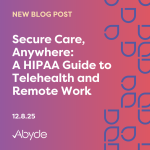May 14, 2020
Is working in your living room with your pets/kids/significant other driving you crazy yet? Us too – but here’s why a measured approach is important to returning back to the office
2020 has been anything but predictable and it’s hard to speculate exactly how life after COVID-19 is going to be – or how soon we’ll get to the point we can call ‘after’. Some healthcare practices along with other businesses have started reopening their doors but with how much has changed over the course of the past few months, it’s easy to find yourself wondering which way is up when it comes to easing back into life outside of the bubble we’ve been living in.
As many organizations transition back from working at the kitchen table in pajamas, the question of “is it safe to bring employees back into the office” is not taken lightly. Practicing social distancing, wearing protective face masks, and self-isolating, if you have any potential symptoms, are all preventative measures that we should anticipate continuing for the foreseeable future. If your practice is considering bringing employees back into an office environment to continue offering medical services, here’s are a few things to consider:
1. Limit Employee Risk in Returning to Work
Healthcare personnel, whether they have been on the front lines during the pandemic or not, have been and will continue to be at risk for contracting or spreading the virus. The CDC issued several strategies on how healthcare providers can determine whether their staff members can safely return to work or not based on monitoring for symptoms over the recommended course of time along with COVID-19 tests.
Some businesses have discussed screening employees for the virus prior to returning to work to ultimately ensure a safer work environment, yet this concept must still take into consideration HIPAA privacy laws regarding testing results being released to businesses. In fact, the HIPAA Privacy Rule does allow for healthcare providers to disclose patient information to employers only if the patient gives written consent authorizing the release or if the testing falls under HIPAA’s workplace medical surveillance exception. If the employer pays for the testing they are eligible to receive information regarding when the testing occurred but, importantly, not the results of the test. Whether you decide to engage in testing or not, make sure that any PHI generated as a result of testing still follows HIPAA guidelines for privacy and security.
2. Prepare for Limited Waivers to Expire
HIPAA has been a headlining topic throughout the pandemic as the CDC has been constantly updating regulations and enforcement discretions to best mitigate health risks to the public. Good faith provisions for disclosing PHI as well as limited waivers for telehealth usage were among the top changes to HIPAA, but as highly emphasized in each waiver, these discretions only remain in place for the duration of the public health emergency. It’s important for healthcare providers to continue to keep HIPAA compliance a priority especially as waivers begin to lift and to be fully prepared to return to normal enforcement.
If your practice has been using telehealth to continue seeing patients, for example, and you might continue to use telehealth even after a return to ‘normal’ operations, it’s essential that you utilize a vendor who offers HIPAA compliant video communication services to do so, and that you get a proper Business Associate Agreement signed with your vendor.
3. Ensure Remote Data Collection is HIPAA-Compliant
You are probably already aware that PHI cannot be sent simply in an email. As many practices have sought new ways to manage remote operations and limit physical interaction, the same encryption and security standards must be applied as your practice would use to send PHI even before COVID-19.
If your practice is considering collecting more patient information or insurance information electronically instead of a physical form or insurance card, make sure you are utilizing a secure system like a patient portal or encrypted email server to transfer any sensitive data.
4. Consider Reviewing Passwords and Security Processes
Over the course of the pandemic, cyber-attacks have been a looming threat, especially to healthcare practices. While working from home played a large role in enabling hackers to access protected information through less-secure networks, it’s important to not lose sight of these concerns even when you go back to your office. Continuing to look out for common scams and knowing how to identify and respond to a potential threat will always be important to ensuring the security of your practice. Consider changing passwords or login information after returning to the office that may have been compromised during remote work, and update your security software to the best possible protection. Review the devices used for remote work to determine if any further action is needed to ensure proper security if still working in part remotely.
With everything that 2020 has thrown our way – being confident and prepared in your ability to get your practice back up and running in a safe and HIPAA compliant manner will make all of the difference in the transition – and help make the rest of the year a little less stressful than the start.





